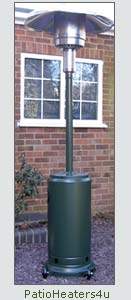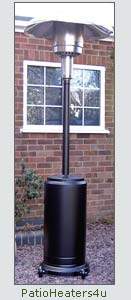Categories
Calendars
Guides
Reviews
Archive
Gallery
Articles
Ask Our Gardening Expert
Design Canopy size is important; generally anything less than
80cm reduces the heat deflection. Single piece canopies are not
repairable, so if the canopy gets damaged a replacement will be
needed. Sectional canopies come in 4, 5 or 7 sections and offer a better
solution. If knocked a single leaf can be replaced at little cost. It
is worth noting that a canopy will act like a sail in storms, so when
severe weather is forecast, it is best to move the heater to a sheltered
location or remove the canopy - most have 3 wing nuts to secure.
A typical heater with
around 40,000BTU's will burn 1KG of fuel per hour at full heat, at lower
settings this will drop to under � KG per hour. Most cylinders contain
13KG of fuel giving 4 to 6 weeks of fuel on average. ENVIRONMENTAL AND GREEN ISSUES
![]()
A Review of Garden Patio Heaters
There are some unsightly garden patio heaters on the market which would
not look good sitting on the terrace. Some are fitted with clumsy doors
for access to the gas; the best models have a sleeker look with hidden
access for gas. Patio heaters may have single piece or sectional
canopies (sometimes called reflector, lid or dome).
 Gas
Gas
Not all garden patio heaters will run on both butane and propane, some are
single fuel only. Always look for units that will run on either. Butane is fine in the summer but not so good in the cold - just when you
might need a patio heater. The best fuel is propane, this will work in
low temperatures and gives a more intense heat.
A few green campaigners have turned their attention to the growing
market for garden patio heaters, launching bias attacks without looking at the
real green issues. A typical criticism is to calculate how much fuel a
patio heater uses, a simple calculation for a simple way of looking at
life. In reality, if a family is enjoying the garden during late spring
or indeed summer and wish to spend longer in their garden into the
evening, a patio heater enables them to stay outside. If the family
could not use the patio heater they would retire indoors, the lights
would go on in several rooms, the TV/video, games consoles and the
central heating, a typical central heating boiler is 10,000 to 30,000BTU
higher than a garden patio heater, resulting in greater energy expenditure than
using a patio heater.
Another favourite argument is to put a jumper on. This can also be done
indoors when it's freezing but the reality is we all turn the heating on
to avoid feeling cold and miserable. A patio heater will consume less
gas per head than the alternative. It's also worth remembering that we
are encouraged to convert our cars to green fuel, and guess what that
fuel is? Yes you're correct, LPG. Patio heaters run on LPG!
POSITIONING YOUR PATIO HEATER
When positioning a patio heater, the key points to consider are:
1. They are for outdoor use, if used within a marquee there must be
plenty of ventilation and 90cm clearance above and to the sides. Some
marquees are
manufactured using flame retardant material.
2. Ensure the surface is level, if wheels are fitted only move when
switched off and the burner has cooled.
3. Always check the gas cylinder and hose to ensure they are in good
order each and every time it's used.
4. If the heater is used to warm the area around a table then one heater
will extend to a table of 10. For a party the best calculation is to
work on a group
of 15 heads per heater.
The technology in today's garden patio heater is tried and tested; they offer
all the style, convenience and ease of modern living, making the garden
a room to enjoy all year round.